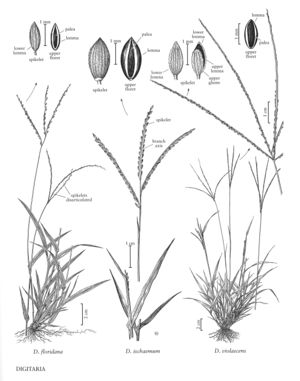Difference between revisions of "Digitaria violascens"
FNA>Volume Importer |
FNA>Volume Importer |
||
| Line 37: | Line 37: | ||
|publication year= | |publication year= | ||
|special status= | |special status= | ||
| − | |source xml=https://jpend@bitbucket.org/aafc-mbb/fna-data-curation.git/src/ | + | |source xml=https://jpend@bitbucket.org/aafc-mbb/fna-data-curation.git/src/f6b125a955440c0872999024f038d74684f65921/coarse_grained_fna_xml/V25/V25_1072.xml |
|subfamily=Poaceae subfam. Panicoideae | |subfamily=Poaceae subfam. Panicoideae | ||
|tribe=Poaceae tribe Paniceae | |tribe=Poaceae tribe Paniceae | ||
Revision as of 19:21, 24 September 2019
Plants annual or of indefinite duration. Culms 15-60 cm, erect, usually not branching from the upper nodes; nodes 3-4. Sheaths glabrous or sparsely pubescent; ligules 0.6-2.5 mm; blades 1.5-9 cm long, 3-5 mm wide, glabrous, with papillose-based hairs basally. Panicles with 2-7 spikelike primary branches in 1-2 verticils; primary branches 3-12 cm, erect to ascend¬ing, axes 0.6-1 mm wide, wing-margined, wings at least 1/2 as wide as the midribs, lower and middle portions of the branches bearing spikelets in groups of 3(4, 5); secondary branches rarely present; axillary inflorescences absent. Spikelets 1.2-1.7 mm, homomorphic, narrowly elliptic. Lower glumes absent or a veinless, membranous rim; upper glumes 1.2-1.4 mm, 1/2 as long as to almost equaling the upper lemmas, 3-veined, appressed-pubescent, hairs minutely verrucose; lower lemmas 1.2-1.7 mm, 5-7-veined, veins equally spaced, region between the 2 inner lateral veins and the margins appressed-pubescent, hairs 0.3-0.5 mm, smooth or minutely verrucose (use 50x magnification), verrucose hairs most abundant near the lemma bases; upper lemmas light brown when immature, dark brown at maturity; anthers 0.4-0.6 mm. 2n = 36.
Distribution
Puerto Rico, Mass., Miss., Tex., Ind., La., Ala., Tenn., N.C., S.C., Pacific Islands (Hawaii), Ga., Okla., Ky., Fla., Ark.
Discussion
Digitaria violascens is a weedy species that is native to tropical regions of the Eastern Hemisphere. It is now established in the Flora region, primarily in the south-eastern United States, and in Mexico and Central America. It grows in disturbed sites.
Selected References
None.
